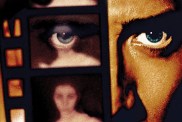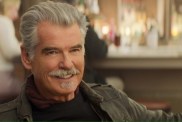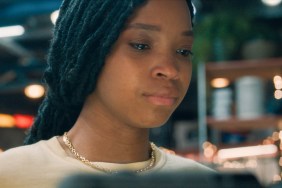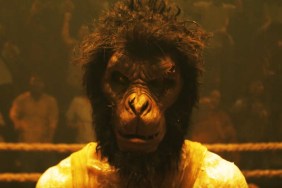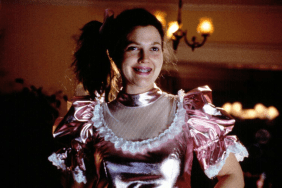An interview with director Mickey Liddell

Teen angst is laid bare on a Petri dish and thrust under the lens of the horror movie microscope once again in Freestyle Releasing’s The Haunting of Molly Hartley (opening October 31st). Except this time, the everyday trials that surround high school life isn’t infiltrated by a witty masked killer, and there is no misfit with telekinesis to propel a firehouse up your ass; Molly Hartley simmers in the cooking pan of the supernatural and features young ‘un Haley Bennett as the titular haunted one who’s got a surprise coming on her 18th birthday. And it isn’t an iPhone or a Porsche.
Molly Hartley also stars Chace Crawford (Gossip Girl), AnnaLynne McCord (Day of the Dead), Jake Weber (Dawn of the Dead) and Jessica Lowndes (Autopsy). Leading this ensemble is Mickey Liddell, a newcomer to the directing chair, but not to teen melodrama. He produced Go in ’99 and the WB series Everwood. Alas, Liddell’s feature debut was not screened for ShockTillYouDrop.com (or press, for that matter), still, in an effort to learn more about Molly Hartley we welcomed a phone interview with him.
ShockTillYouDrop.com: We’re creeping up on Halloween. It must feel pretty exciting to have a horror film opening on that day.
Mickey Liddell: It’s exciting, it really is. We set the date a while back and when they told me, I was thought it’d be fun. But now, as it gets closer, I think it’s so cool. Especially now that Saw has already opened this last weekend.
Shock: Did that come as a relief, knowing you were a week later?
Liddell: It really is and [Saw] is such a different movie. We all know what they are, but I like to think of [Molly Hartley] as a different type of movie. It’s really scary, still really creepy and it gets inside your head, but in a different way.
Shock: You’ve been producing for a while, so what events set you on this path to make your directorial debut with a horror film?
Liddell: I was looking to direct after producing features and television. All of my favorite scary movies are from the ’70s. Everything from The Omen to Carrie to Rosemary’s Baby to The Shining. All of those movies that scared the crap out of me, but stayed with you. They were psychological. [Writer] John Travis [of The New Daughter] had this great idea about a girl who, on her 18th birthday, new the devil was coming for her. Her parents had made a deal. I thought that was so great. It made me feel how I felt when leaving high school and going to college. Things were changing beyond your control and you could never put things back the way that they were. I thought [what John did with his script] go under my skin. I thought, This is it. I loved working with teens, I love the horror genre. But I don’t think I’d be good directing something like Captivity or anything in that vein. I wanted something where you related to the characters and got scared because you were with them the whole time.
Shock: And you then brought in writer Rebecca Sonnenshine (American Zombie)?
Liddell: Because she had a written so many other scripts that were great, too. I felt like she really got all of the girls, the female dialogue and everything. She was really smart about not over-writing it. So many scripts I read are over-written in the female dialogue. And Rebecca did a great job of avoiding that. She kept it real and in touch with what these girls are going through.
Shock: Wearing a producer’s hat for so long must have helped you pull together a good team.
Liddell: It did. And I had a good producer, Jennifer Hilton, did an amazing job with it. Everybody I had worked with through the years showed up. For the budget we were doing, I knew I could do it – where to put the money and put the time. It also helped a lot that I had done everything from The Broken Hearts Club to Everwood where I had cast teens before. So I could [go into casting] and look for teens that were perfect for the roles. And we got so lucky for that.

Shock: Any good horror film works on various levels and you had mentioned how this tapped into those fears of change and the unknown, can you elaborate more on that and how this separates itself from the other coming of age horror stories we’ve seen?
Liddell: What I really worked with Haley on, sort of in the way Rosemary’s Baby worked in the way that Mia Farrow kept asking, Is it because I’m pregnant? Am I going through all of this because my body is changing? I really kept going back to that here. In every scene I’d ask, What is this about? What’s different about this is: Is this really happening to her? She just turned 18 and she’s acting like a normal girl. I think girls at that age feel that way. They have to leave home. They’re separating from their parents. In Molly’s case, she had a tragedy with her mother who tried to kill her. Everything she knew before is coming into question. I think girls really feel like that when they’re becoming women. And ever character plays into that. Except everything that’s happening to Molly is happening much, much bigger and scarier. Who believes her? Who’s on her side? That’s another thing – almost every character you might think is crazy in the film or religious or not religious, you’re never quite sure who’s on Molly’s side.
Shock: Now that you have a horror film under your belt, did you find shooting it for a PG-13 rating difficult?
Liddell: I just knew I wanted a PG-13 movie with a lot of scares. I worked it out and knew there were certain things I couldn’t do and things I could do. I believe a lot of movies that I grew up with would be rated PG-13 today. I think what’s turned a lot of horror films into R-rated ones is the torture porn, gore and stuff like that. I still feel like, when working with the writers and the entire time we were doing it, I wanted the scares to come from, Oh my God, don’t go in there. Or, Don’t do that. All of the feelings you have when you’re in a situation you shouldn’t be in. It definitely does, at least to the people we’ve shown it to, has all of the jumps which were built into the script.
Shock: You needed to find the perfect girl for Molly, so where did Haley come from?
Liddell: That was so hard. [laughs] I almost quit two or three times because I couldn’t find the right girl, I just didn’t want to do it. We saw everybody. I mean, every person that’s even close to that age. I had some criteria. First of all, I wanted her to be a true 18, which Haley was, which was really important to me because – having done Go and Everwood, you know we had Katie Holmes and Sarah Polley who were 18 or 19 at the time. It’s just so hard when girls get too old they forget what that feels like. I kept seeing girls who have lost that innocence. [When you’re 18] everything does scare you, everything is new to you. And Haley came in and had that. Literally, everything in her life – she had done Music and Lyrics and she had to leave her family, lives here in L.A., she is 18 living on her own. Everything she was going through just came through. It was easy for her to get to those places. On set she’d just cry and cry and cry in scenes and her challenge was to pull back to where we can start to see it again.

Shock: And with Gossip Girl being a hit, I’m sure you’re glad you got Chace Crawford.
Liddell: When we got him, I don’t even know if he had done the pilot for Gossip Girl or it hadn’t been picked up at the time. We didn’t know anything about him at the time, but he came in and was just so right for the role. Again, without giving away too much, he was just so perfect for who you’d pick for a role like this. He auditioned and tested with everyone. We put him with Haley and they just had perfect chemistry together.
Shock: Speaking of challenges, you seemed caught between two. The first being, tackling your directorial debut and the second, making a horror movie scary.
Liddell: It was so much harder and not very fun. Shooting it was harder than any producing I had done. It never became fun until I started editing. It was the whole feeling of, Will I get this shot? Will I get the performance I want? I had it all in my head, but when you actually get there, everything changes. So I felt like I was on the edge of my seat the entire time directing it. I just went back and watched every movie from 1950 to every movie I liked. I just looked at what worked. I just worked really hard to make sure the tension was going the whole time.
Shock: Well, having done your homework, what particular scenes stand out in the film for you now?
Liddell: There was one scene that was really important to me, one that I had Rebecca put into the script. There is a lot of religion I brought into the script, there wasn’t as much in John’s draft. I grew up in Oklahoma in more of an Evangelical Christian family and I really wanted that in the script a lot. Most of the time, the Christians are just crazy and out of control, but here when you see the film, there are a lot of good points. Molly’s mom is out of control and doing crazy things but she’s also trying to save her from even darker things. There’s a baptism scene I put into the film. When I was growing up in the Baptist church, I was baptized in this glass pool is on the wall behind the preacher. I looked everywhere for that [for the film] and we just couldn’t find any churches with that. It was one of the scariest things I went through. You walk down with a robe and the preacher takes you and dunks you under. The whole congregation is watching. It’s just spooky. So I put that in the movie and something really big happens. We shot it in a church here, and I’m not sure if the church quite knew what we were doing – we had lots of stuff going on with blood and that was just great.
For more information on The Haunting of Molly Hartley – including photos and a trailer – click here.
Source: Ryan Rotten

